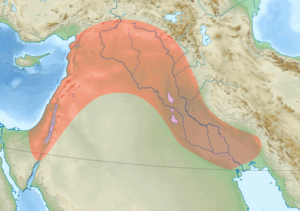Hilly Flanks

The Hilly Flanks is an area curving around the Tigris, Euphrates, and Jordan valleys in Western Asia.[1] It was the location of one of the world’s first civilizations, Mesopotamia, and was the origin of the idea of irrigation. [2]
The people in this early civilization were surrounded by water from the rivers, so it was easy to divert water and form "man-made" rivers for trade and irrigation. Eventually these man-made rivers connected the two rivers which helped with trade and travel. This area is known for its sufficient rainfall which leads to the over abundance of wild wheat and barley. Peoples in this area also started the first signs of domesticating animal and plant life. Animals like pigs, sheep, and goats were all wild and were domesticated for human help.
Robert Braidwood proposed the Hilly Flanks hypothesis in 1948, suggesting that agriculture began in the hilly flanks of the Taurus and Zagros mountains, and that it developed from intensive focused grain gathering in the region, where fertile land supported a variety of plants and animals amenable to domestication.[3]
See also
References
- ^ Morris, Ian (2010). Why the West Rules—For Now. Farrar, Straus and Giroux. ISBN 978-0374290023.
{{cite book}}: Cite has empty unknown parameter:|coauthors=(help) - ^ Kottak, Conrad Phillip. "Chapter 7". Windows on Humanity. pp. 153–154.
- ^ Charles E. Redman (1978). Rise of Civilization: From Early Hunters to Urban Society in the Ancient Near East. San Francisco: Freeman.
